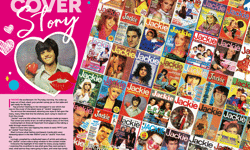Like many magazines, Vogue’s circulation has declined in recent years. The difference is that Vogue looks set to remain on the newsstands long after other titles have died. Why? Because Alexandra Shulman believes in innovation and is obsessive in her quest to engage the readers, all of whom love the magazine – as do the team who produce it.
As she approaches 2017, marking her 25th year editing Condé Nast’s flagship title, her fervour is as fresh as the latest issue’s content. Alexandra doesn’t believe in doing things without a valid rationale, which became apparent as soon as she took over the editorship from Liz Tilberis in 1992. Having left GQ to take the helm, her background – working for national newspapers and Tatler – meant that she was willing to challenge existing structures. Something all new editors should do.
“When I first took over, there were certain things that I didn’t understand. For instance, the way fashion shoots are put together.” It was a steep learning curve. “I had to learn to find out whether what was being done was done because that is the way it has to be or because it had always been done that way.”
Every editor has their own vision and makes changes accordingly. One of the first Alexandra made was to give the magazine a wider editorial scope. “I wanted to have a slightly broader approach to fashion and to bring more writing to the magazine,” she says, adding other changes included featuring more high street and middle market clothes in the magazine.
There were, she admits, a few changes of staff in those early days. “People left as they often do when the new person comes in and so I ended up with quite a new team.”
With hindsight, Alexandra reveals she would have tried to make changes more rapidly. “Because of how little I knew, I was cautious and not determined enough in my opinions. I should have had more confidence in those early days.”
Her achievements include growing the circulation despite a challenging climate. “I am proud of the fact that people enjoy reading it as much as they enjoy looking at it. Something that I think was true at other periods in its history, but possibly not so much when I inherited it. Vogue is a fantastic brand, it’s a great honour to be in charge. It also means that there is also a lot to mess up but I don't think I have actually messed anything up.”
Becoming sustainable
The magazine has evolved considerably under her editorship. Despite a dip in its print circulation – which according to ABC (Jan-June 2016) stands at 186,033 – Vogue has a readership of 1,126,000 and is one of the few magazines where issues become collectors’ items. Its editorial pillars have expanded to all areas of fashion including sport. As I write this piece, the August issue is on sale featuring an interview with Olympic champion flyweight boxer, Nicola Adams – not something I would have expected to find in Vogue.
Fashion bible it might be, but the content is thoughtful, engaging and built on solid journalistic values. “For me, the great joy of Vogue is that it does have quite a wide remit. Although fashion is very much its kind of spine, you are able to hang other things off it. Whether that’s business, film or social observation, you can deal with a lot of different subject matter which I like.”
The most challenging aspect of her role is perhaps juggling everything and making fast decisions when heading up a big team. “Your mind flips from one subject to another, making decisions about different things all the time. When people ask you something, they want an answer. Sometimes you will be making a decision that will veer from, where you are going to have a party, how many pages a piece is going to be or to something completely different about somebody’s job or whatever.”
Since Alexandra took over, there have been substantial changes in technology that have had a huge impact on magazines and the fashion industry. “There is a great deal more fashion around so the pressure to know more about it, to be able to include more and keep on top of it has increased. When I came to Vogue, and when Liz was editing it - it was very much about dealing with the big fashion houses, having very close relationships with them and knowing everything that’s going on. But there wasn’t anything like the number of brands there are now
“There were just twelve magazines a year – that was the job. And now there are twelve magazines, four supplements, a website, Vogue video, now the festival, so there’s three times the amount to be keeping on top of. Having said that, it’s really interesting and exciting. Brand extensions have not only driven revenue, but increased the title’s visibility. During the recession, the team devised Fashion’s Night Out, an event that sought to boost the high street. It was, Alexandra recalls, extremely popular. “After the 2008 slump, it was about celebrating the idea of fashion and shopping to help drive people back into stores.”
One perhaps more profitable extension is the Vogue Festival. “It’s all about the magazine not other shops – and we know people pay to come,” says Alexandra, adding that the brand is set to launch another event extension, Vogue Salons’ Night Out, in the autumn. “We are working with hair salons; it will be in the image of Fashion’s Night Out.”
But do brand extensions achieve sustainability for print? “They certainly contribute. What the brand extensions are doing are slightly stopping up that gap, but I wouldn’t say at the moment they totally do so.”
A digital age
The technological era has caused some titles to struggle both in terms of revenue and the demands on the teams, but Alexandra has seen such developments as opportunities rather than problems. As a result, Vogue was one of the first magazines to have a website and Condé Nast is now investing in its digital content in “a major way”.
“We now have a fantastic audience for that and all our social media has huge numbers - real interest and loyal engagement. At the moment, we are re-designing our website so it’s going to be better and more flexible as, currently, websites are very formatted. It will be up and running before the Fashion Show which will be great.”
Vogue used to take a separate digital and print approach, Alexandra tells me, with the digital department based away from the editorial team. “While the teams are not 100% integrated because we take the view that different people have different strengths - we do work much more closely together. My print journalists write for online and online journalists take the baton on from a story that the print team are doing.”
Unlike most titles, Vogue’s team has grown and now includes a post to facilitate the title’s events: “It’s a lot of work and we are always looking at ways to outsource a lot of it, but the problem is that you really need someone from the inside. Someone who understands what your preoccupations are and what you have got to achieve; it is difficult to get that from somebody outside.”
Digital is, she admits, as a whole, still a relatively small part of their revenue stream, while social media is more focused on audience engagement.
“I think that social media allows people to engage with the notion of Vogue. It’s good for the future of the title that more people are interested in the idea of it. I don’t think it makes a huge difference to the amount of people who actually spend money to buy the magazine. That’s the Holy Grail. Everyone has got to work out how to use their social media to actually drive people to buy magazines. It does a bit, but not a huge amount as many of those who engage with Vogue via social media would never buy a glossy magazine based in the UK about expensive fashion.”
As every editor knows, it’s about converting those numbers into paid-for copies, a successful strategy for which seems to have eluded many publishers. Alexandra takes a cautious approach. “I think that the more you put out that allows people to access an element of Vogue for free – whether that’s something like Apple News or putting pieces online or our Instagram feed – you are actually diverting them away from buying that magazine because you need time to read it. If you can fulfil a bit of desire through these other things, then it’s much harder to say to people, ‘hang on, it’s the magazine you’ve got to get’.
“That would all be very well if there was enough revenue coming through that, but as all publishers know there is a gap. Mind the gap…”
The future
So is print dead? “No,” says Alexandra, who admits she sees the iPad as a “transitory” thing. “My opinion is that, at the moment, the idea of a tablet app has to be viewed as a niche product that people want for one reason or another to read Vogue magazine in that way. The magazine is very tactile, it’s a treat and the print production is very much part of its USP. I’m not sure that a digital app is ever going to be the best way to see Vogue.
“Everybody is saying, it’s moving towards mobile. We have a mobile version as well, but it’s hard to really see that this is going to be the way people will choose to read the magazine. They will read other Vogue content, but my feeling is that what I produce – as a monthly magazine – is best viewed in print. The app is great if you travel a lot, such as women who fly around the world the whole time and buy all their magazines on their iPad and it’s job done for the aeroplane. There are really good reasons for having an app.
“Four years ago, everyone was saying in two years’ time, everyone will be reading magazines on the iPad. Well I never thought they would and they aren’t.”
Her vision for Vogue in 2026? “I’m sure there will be a print magazine – if anything, I think it might be bigger and more expensive and more luxurious. I think the direction of travel will be to make the print more exceptional and use the other aspects to do different things. That would be my guess.”
Inside Vogue: A Diary of My 100th Year, by Alexandra Shulman is published by Fig Tree in hardback and eBook. It will be on sale from 27th October, priced £16.99.












